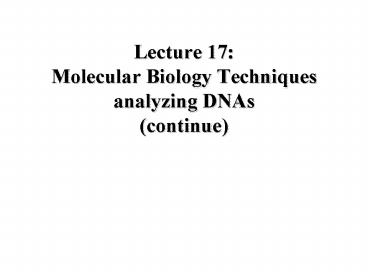Lecture 17: Molecular Biology Techniques analyzing DNAs continue - PowerPoint PPT Presentation
1 / 14
Title:
Lecture 17: Molecular Biology Techniques analyzing DNAs continue
Description:
Application II (DNA fingerprinting) Restriction enzyme/modification ... Application II (DNA fingerprinting) PCR amplification of variable regions ... – PowerPoint PPT presentation
Number of Views:75
Avg rating:3.0/5.0
Title: Lecture 17: Molecular Biology Techniques analyzing DNAs continue
1
Lecture 17Molecular Biology Techniquesanalyzing
DNAs(continue)
2
Outline
- Molecular Biology in general
- Genotypes and genetic markers
- Polymerase Chain Reaction
- Gel electrophoresis
- Applications I (linkage mapping)
- Restriction enzyme digestion
- Application II (DNA fingerprinting)
3
Restriction enzyme/modification
- Defense mechanism of bacteria
- -gt DNA cutting enzymes
- (sequence-specific)
- Restriction Enzymes
- -gt its own DNA is protected from
- cutting by modifying DNAs
- (sequence-specific)
- Modification Enzymes
- GATC-modifying enzyme
- in DNA repair
4
Restriction enzymes
- Sequence-specific endonuclease
- break phosphodiester bond
- Sensitive to methylation on DNAs
- restriction modification
- Sequence of recognition sites
- palindromic
- Blunt vs sticky ends
- Recognition sites (4 to 8 bp long)
- - size determines frequency
5
Restriction enzymes
- Sequence-specific endonuclease
- break phosphodiester bond
- Sensitive to methylation on DNAs
- restriction modification
- Sequence of recognition sites
- palindromic
- Blunt vs sticky ends
- Recognition sites (4 to 8 bp long)
- - size determines frequency
6
Cloning with Restriction enzymes
Large pieces of DNAs (Chromosomes) -1) shortened
into small pieces by R.E. -2) ligated into
plasmid of bacteria -3) amplified and maintained
in bacteria Human Genome Sequencing and other
molecular biology are based on this molecular
(DNA) cloning!!!!
7
Restriction enzyme map (sample)
You need to derive a restriction map of one
bacterial plasmid (3kb in length) containing a
9-kb long human DNA fragment. You digested this
circular plasmidw with the following restriction
enzymes. The sizes of digested fragments are
listed as shown in the table. With this
information, draw the map.
EcoRI 12 kb BamHI 3, 9 kb EcoRIBamHI 3, 4, 5
kb
8
Restriction enzyme in genetics
Restriction enzyme digestion can provide unique
patterns of digested DNA fragments The size of
the digested fragments can be variable due to
the sequence variation among individuals ----gt
can be a genetic marker ----gt used for
genotyping Restriction Fragment Length
Polymorphism
9
Restriction enzyme in genetics
Restriction enzyme digestion of a PCR product can
provide a quick genotyping and diagnostic tool
10
Application II (DNA fingerprinting)
Variable regions of chromosomes can provide a
genetic profile of a given individual -----gt
forensics
11
Application II (DNA fingerprinting)
PCR amplification of variable regions of
chromosomes can provide a genetic profile of a
given individual -----gt forensics Most
frequently used marker SSLP (simple sequence
length polymorphism) Any given marker ---gt more
than 2 alleles 5 to 10 alleles
12
Application II (DNA fingerprinting)
PCR amplification of variable regions of
chromosomes can provide a genetic profile of a
given individual -----gt forensics Most
frequently used marker SSLP (simple sequence
length polymorphism) Any given marker ---gt more
than 2 alleles 5 to 10 alleles
13
Sample test
14
Homework assignment for this week
In-class homework !































